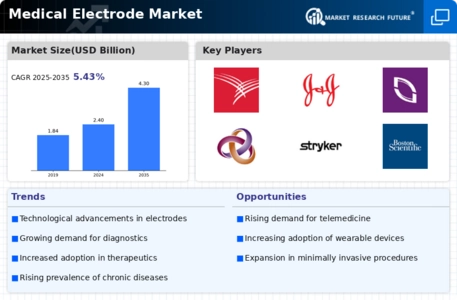Growing Focus on Telemedicine
The Medical Electrode Market is significantly impacted by the growing focus on telemedicine. As healthcare providers increasingly adopt remote monitoring solutions, the demand for portable and efficient medical electrodes rises. These electrodes facilitate real-time data transmission, allowing healthcare professionals to monitor patients' conditions from a distance. The telemedicine market is expected to expand at a CAGR of around 25% in the coming years, which directly correlates with the increased use of medical electrodes in remote patient monitoring. This trend not only enhances patient care but also drives innovation within the Medical Electrode Market, as manufacturers strive to develop electrodes that meet the specific needs of telehealth applications.
Emphasis on Patient-Centric Care
The Medical Electrode Market is increasingly influenced by the emphasis on patient-centric care. Healthcare providers are shifting their focus towards personalized treatment plans, which necessitate the use of advanced medical electrodes for accurate monitoring and assessment. This trend is particularly relevant in the management of chronic conditions, where continuous monitoring is essential. The market is witnessing a rise in demand for electrodes that offer enhanced functionality and ease of use, aligning with the broader healthcare trend of improving patient outcomes. As a result, manufacturers are likely to invest in research and development to create innovative solutions that cater to this growing need, further propelling the Medical Electrode Market.
Rising Demand for Diagnostic Procedures
The Medical Electrode Market experiences a notable surge in demand for diagnostic procedures, driven by an increasing prevalence of chronic diseases. As healthcare systems prioritize early detection and monitoring, the utilization of medical electrodes in electrocardiograms (ECGs) and electromyography (EMG) has expanded. Reports indicate that the market for diagnostic electrodes is projected to grow at a compound annual growth rate (CAGR) of approximately 6.5% over the next five years. This growth is attributed to advancements in electrode technology, enhancing the accuracy and reliability of diagnostic tests. Consequently, healthcare providers are increasingly adopting these technologies, thereby propelling the Medical Electrode Market forward.
Technological Advancements in Electrode Design
Innovations in electrode design significantly influence the Medical Electrode Market. The development of flexible, biocompatible materials enhances patient comfort and signal quality, which is crucial for accurate diagnostics. Recent advancements include the introduction of dry electrodes that eliminate the need for conductive gels, streamlining the application process. These innovations not only improve the user experience but also reduce the overall costs associated with electrode use. As a result, the market is witnessing a shift towards these advanced products, with projections indicating a potential increase in market share for innovative electrode designs. This trend underscores the importance of continuous research and development in the Medical Electrode Market.
Increasing Investment in Healthcare Infrastructure
Investment in healthcare infrastructure plays a pivotal role in shaping the Medical Electrode Market. Governments and private entities are channeling resources into upgrading healthcare facilities, which includes the procurement of advanced medical equipment. This investment is particularly evident in emerging economies, where the demand for quality healthcare services is on the rise. As healthcare facilities expand and modernize, the need for reliable medical electrodes becomes paramount. Market analysts suggest that this trend could lead to a substantial increase in the Medical Electrode Market, with an anticipated growth rate of 7% over the next few years, driven by enhanced healthcare capabilities.

















Leave a Comment